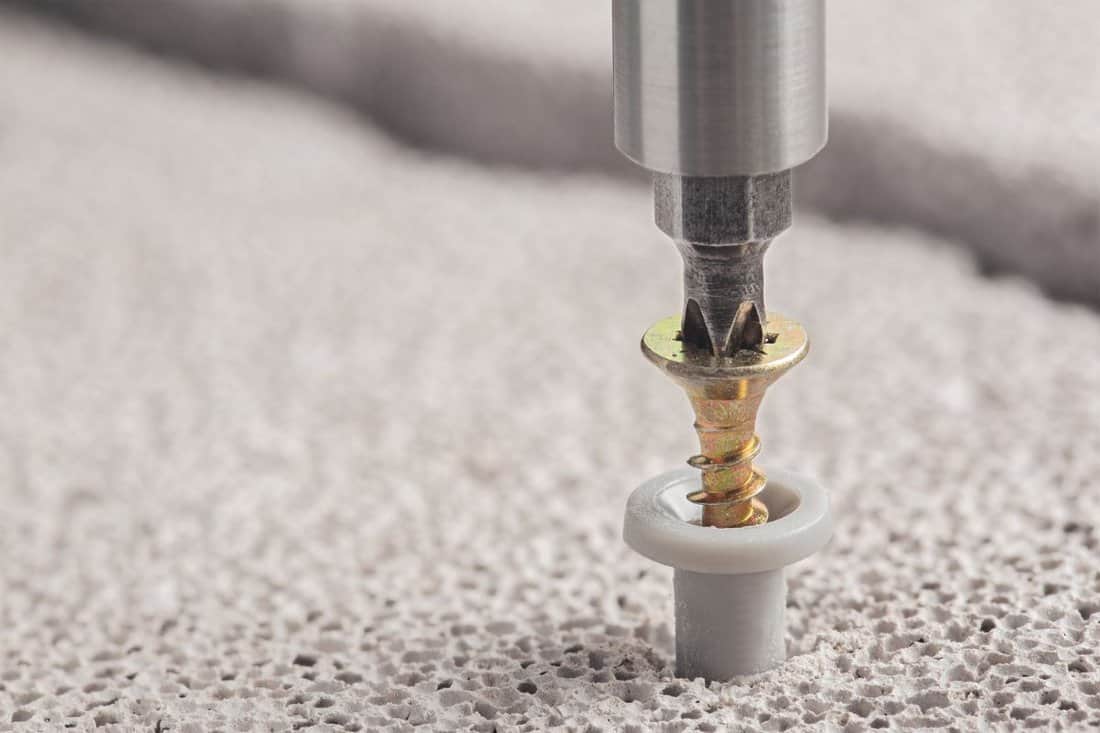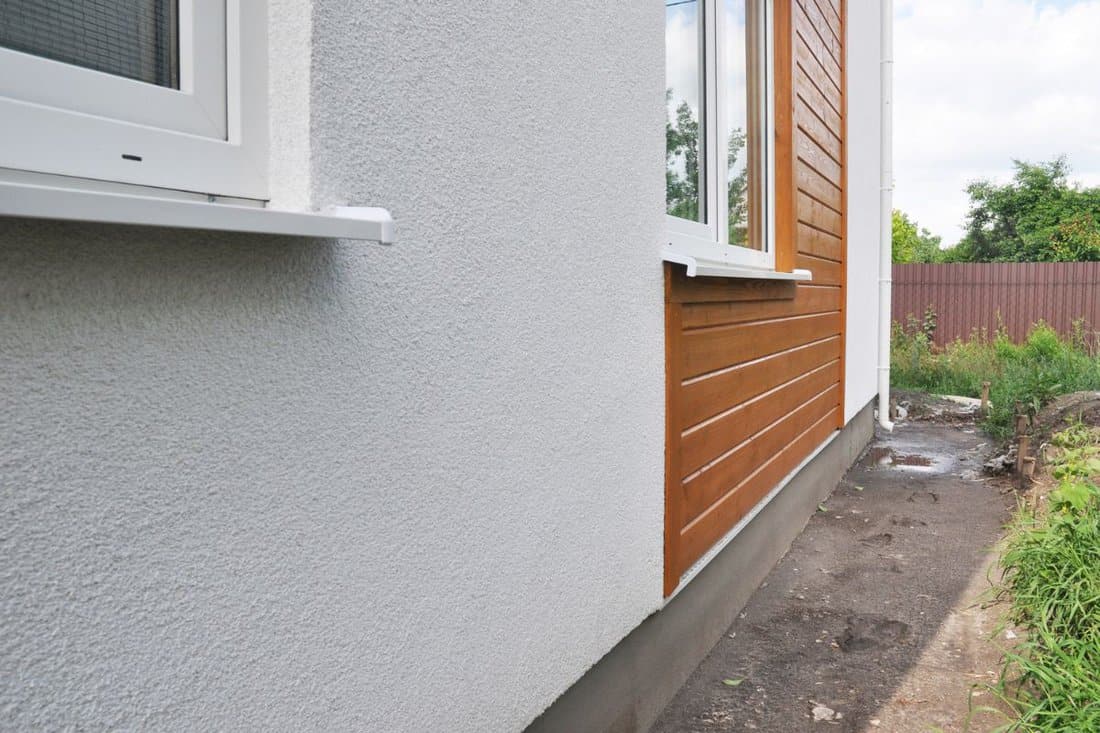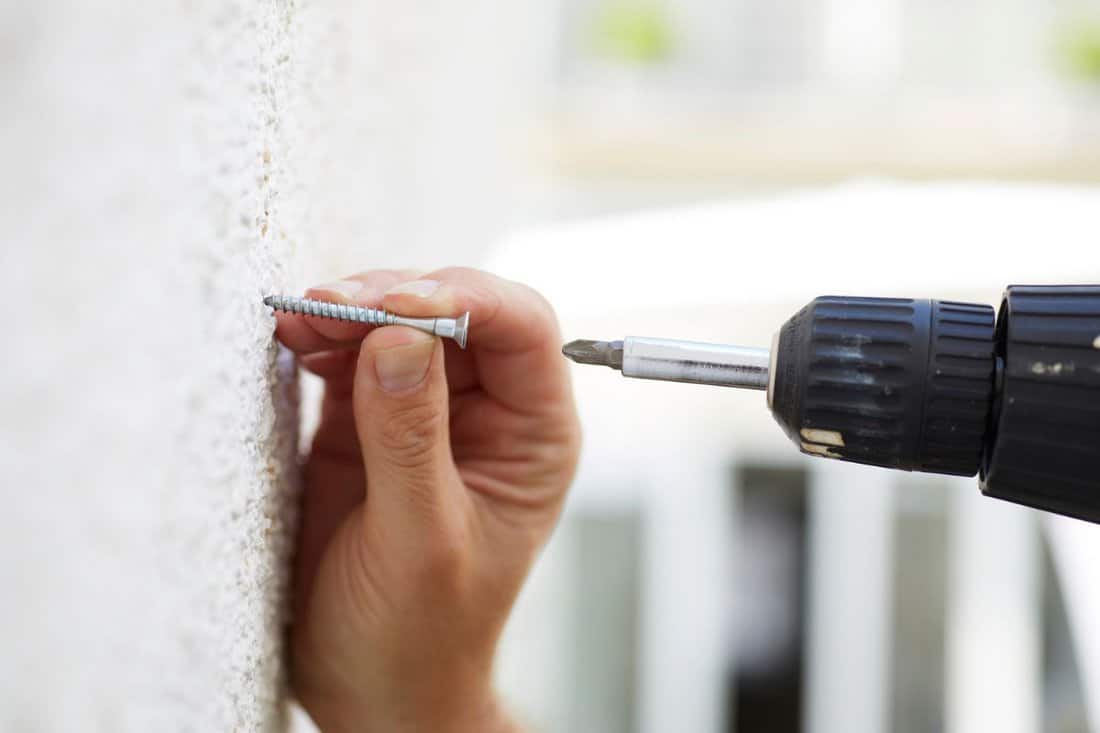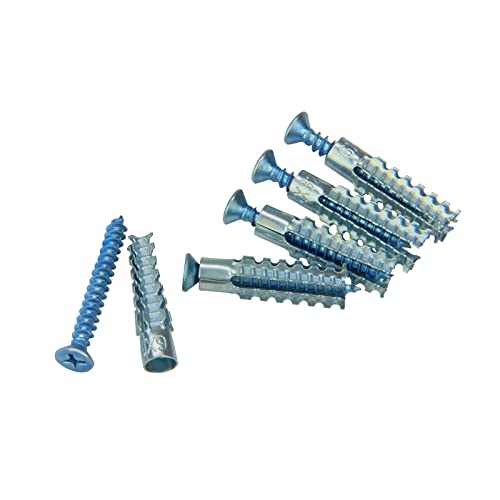Stucco is a plaster-type finish that needs a different approach when you want to mount a screw. We've got you covered if you are looking for simple directions and guidance on how to screw into the stucco. Let's check out how to do this below!
Mounting a screw on a stucco wall is not as simple as drilling the screw in. You'd need special screws, anchors, and a hammer drill to do the job.
To get this done:
- Assembling necessary tools.
- Preparing the work area.
- Drilling a pilot hole.
- Adding caulk into the hole.
- Placing the screw anchor into the pilot hole.
- Inserting the screw.
- Tightening the screw using a drill.
Keep reading as we detail each step further and give you information on the best screws and anchors. More importantly, we have tips on how to keep the screws attached. Let's begin!
![Close up of an electric drill screwing a screw into a wall, How To Screw Into Stucco [Inc. Best Screws, Anchors, & Tips For Success]](https://homedecorbliss.com/wp-content/uploads/2022/10/Close-up-of-an-electric-drill-screwing-a-screw-into-a-wall.-How-To-Screw-Into-Stucco-Inc.-Best-Screws-Anchors-Tips-Fo.png)
How To Drill Into Stucco Without Cracking It
Stucco covers walls to give them extra texture. It consists of a binding agent with sand and water. When it is just applied, it looks like a paste. However, it becomes tough when it dries.
Though it is hard, you must be careful when drilling into it. Unlike regular cement walls, drilling into stucco requires special screws and drills.
You also need to put an anchor to support the screw.
We sometimes add affiliate links and content that was curated and created by our team with the help of advanced ai tools to help showcase the best design styles.

Be careful in this task, as stucco tends to give in and crack under pressure. These are easy-to-follow steps in drilling into the stucco.
1. Assemble Necessary Tools
As mentioned, when you are drilling into stucco, you must have the following:
- The right screws
- A tape measure or a meter for measuring
- An anchor
- Pencil/marker
- A masonry bit
- A hammer drill
2. Prepare The Work Area
After you have prepared the area, take measurements for the screw. Use a tape measure to get the exact dimensions. You don't want to drill and re-drill into the wall. Mark the area using your pencil or marker.
3. Create A Pilot Hole
Because stucco is hard, it tends to chip if too much pressure is applied. A pilot hole will reduce the risk of the stucco chipping.
Next, attach the masonry bit, with a diamond tip, to the hammer because it works well on stucco. Start drilling upright to ensure that the hole goes straight. Be careful with the pressure you apply.
As much as possible, let the drill move forward. If you need to push it, do it so lightly. Keep drilling until you have reached your desired depth. Brush off the dust the drilling produced.
Click here to see this drill bit on Amazon.
4. Add Caulk Into The Hole
Fill the hole with caulk. Doing this will prevent damage to the stucco.
5. Place The Screw Anchor Into The Pilot Hole

Before the caulk dries, insert the anchor into the hole. Note that this is a must if you're hanging heavy objects.
However, an anchor is unnecessary if you intend to use the screws you have drilled for light objects. Nudge the anchor into the hole with a hammer or a screwdriver.
6. Insert The Screw
Once the anchor is in place, use special screws with diamond tips. The diamond tip feature helps the screw pierce into the material quickly and without damage.
These screws are ideal for hard materials like stucco and concrete.
7. Tighten The Screw Using A Drill
Finally, using a screwdriver bit, drill the screws further. Do not tighten the screw all the way. Let the head stick out enough to hold whatever you will hang.
What Are The Best Screws For Stucco?
Different types of concrete and stucco screws are available. Several brands offer suitable quality screws that'll suit your needs. Here are some samples:
Concrete Diamond Point Screw
It's a self-tapping screw that is directly mounted on stucco.
Check out this stucco screw on Amazon.
Velocity Concrete Screw
The screw is designed with a moisture barrier system. The patented RedSeal Technology creates a barrier and seals tight. Because of this, the screw is suitable for outdoor use.
Click here to see this screw on Amazon.
Buildex Stucco Screw
It is a partially threaded roundhead screw. The screw is made of zinc and steel alloy, which makes it durable for fastening applications on stucco. This particular brand comes in a set with an anchor.
You can click here to buy this screw on Amazon.
Best Wall Anchors For Stucco

Anchors are necessary, and here are some anchors in the market which you can use for stucco.
Heavy Duty Steel Wall Anchor
This type of anchor is steel and can be used on different surfaces, including stucco.
It is durable and can withstand heavy loads. This particular sample expands after screwing the screw, which makes the anchors firmly attached.
Click here to see this steel anchor on Amazon.
Ribbed Plastic Conical Anchor
It's one of the best plastic anchors for small and big mounting jobs.
It's a multipurpose anchor for wood, brick, concrete, sheet metal, and stucco. Although it's plastic, the high-quality materials ensure that screws don't rust or corrode easily.
Check out this plastic anchor on Amazon.
Heavy-Duty Metal Anchor
The zinc anchor is designed to offer a stronghold. Because of its design, the anchors don't require pre-drilling.
You can find these metal anchors on Amazon.
Conical Concrete Wall Anchors
The anchor is of high-quality polyethylene that can withstand heavy loads and protect the mounting materials. It'll also prevent rust and corrosion.
Click here to see this anchor on Amazon.
How To Screw Into Stucco Without A Drill

Although it may take some effort, you can screw into stucco without the help of a drill. However, you have to use still the special screws mentioned in the previous section. After preparation, measure the area, and mark it accordingly.
Next, get a self-tapping screw and a screwdriver. What's good about self-tapping screws is that it has a sharp edge that you can use to puncture the stucco. Remember, it'll take some time as stucco is hard.
With that in mind, be gentle when puncturing the stucco to avoid damaging it. Slowly push the screw until you reach the desired depth.
When Should You Not Drill Into Stucco?
Although drilling into stucco is okay, it is not always the case. You have to inspect the stucco first and consider the factors below:
Is The Stucco The Right Type?
There are two main types of stucco. If you have a traditional stucco made of sand, lime, and water, it is safe to drill on it. Synthetic stucco doesn't use cement, unlike traditional ones.
So, it is not always advisable to drill into it.
Is The Stucco Damaged?
Additionally, watch out for cracks. If there are cracks, no matter how small, you should not drill into the stucco. You must repair the damage and wait for it to dry before drilling.
Inspect The Area
Before you measure and mark the area to be drilled, ensure there are no electrical wirings in the wall. Working around these electrical wires is dangerous as there is a risk of electrical shocks.
Moreover, there is also a potential risk of fire when you accidentally drill into an electrical wire.
Can You Repair Damaged Stucco?
Although known for its durability, there are several reasons why the stucco might need repair.
There may be cracks, holes, or wear and tear as time passes. It would help if you took care of it immediately before the damage becomes irreversible.
It is relatively easy to repair small holes or cracks. You have to clean the area by lightly brushing or dusting. After cleaning, fill the gap with caulk. Finally, you can cover the caulk with paint once the caulk is dry.
More extensive damage requires more than just caulking. It'll involve patching with new stucco. When cleaning the repair area, fill in gaps with premixed stucco using a putty knife or spatula.
Use a putty knife to apply the stucco until it appears smooth. Next, add texture using a wire brush. Match the existing stucco and hide your repairs. Lastly, let the patch dry and paint as necessary.
Our Final Thoughts
Note that screwing into stucco is unlike screwing into a regular cement wall. Due to the risk of cracking, apply a little force and let your drill do the job. Use special screws, anchors, and drill bits.
Lastly, before you screw into the stucco, ensure no damages or electrical wires are behind. Having read the guide on drilling a screw into stucco, you can now be confident to do it independently.
If you found this post helpful, please check out these other articles:









